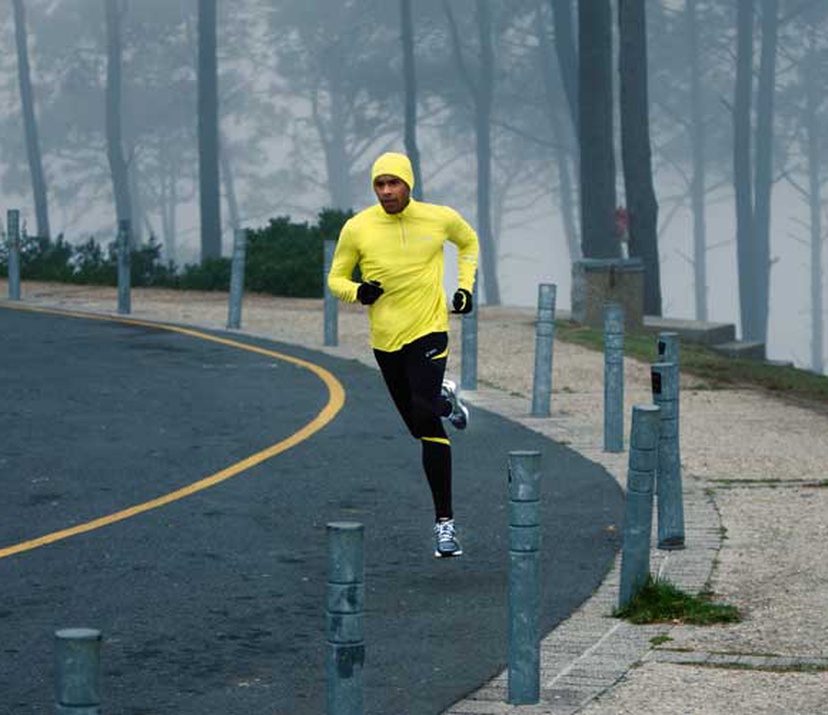Defy the weather and keep a running routine.
Dark evenings and wet mornings can make winter running a challenge. But taking the right approach to winter running can make it easier to defy the weather and stick to your running routine.
Daylight?
First of all, consider if you can fit running in during the day in winter. For instance, can you run at lunch time? Or would you mind running on a treadmill for the winter? While running outdoors in winter can earn you a 'hardcore runner' badge it can also mean more chills and lonely running.
Living in Switzerland, marathon runner Viktor Röthlin is used to winter weather, and it has never kept him from training. "Well, if I can't open the door of my house because of too much snow outside, I don't run."
At the same time he advises: "If it's minus zero don't run hard outside. Do your hard sessions indoor or on the treadmill. Easy runs you can enjoy outside, especially if there is fresh snow coming down. It's one of the greatest highlights to be the first one on the path, all untrodden except for some wild animal tracks."
“ Easy runs you can enjoy outside, especially if there is fresh snow coming down. It's one of the greatest highlights to be the first one on the path, all untrodden except for some wild animal tracks.” — Viktor Röthlin
If you do continue to run outside in winter, try to pick places which are well lit, and safe. Consider finding a running buddy for the winter months. This will motivate you to run and help pass the time when the dreariness becomes too monotonous.
Dress smartly
Make sure you dress smartly for winter running. Wear a technical base layer shirt, which wicks moisture away from the skin. A winter top can then go on top of this. If it's windy or raining, wear a jacket. All of your winter clothing should be breathable, allowing you to stay warm without overheating.
If it's windy or raining, wear a jacket. All of your winter clothing should be breathable, allowing you to stay warm without overheating. Röthlin: "I always say it's never too cold or too wet as long as you wear the right clothes. I have two complete stores of clothes, one for summer and one for winter running. With the newest clothing technology like seamless or Inner-Muscle, to run in the cold time of the year feels much better than in the past. To be dressed well, behave like an onion: put on clothes in different layers. You may also need trail shoes for running in wintertime."
Visibility
Perhaps the most important aspect of running in winter is visibility. Make sure you are visible to motorists. Wear a fluorescent jacket or bib. Clip-on lights are also an excellent idea for standing out. Being visible will ensure you make it back to springtime running in top shape.
Shoe care
Your shoes may need extra attention for winter running. With the proper shoe care they will last much longer. After running in rain or snow, clean them with a cloth and remove the insoles if you can. Then stuff them with newspaper, so the moisture from the inside of the shoe will be absorbed. Finally, don't forget your socks. They should wick wetness away from your feet, keeping them warm inside the shoe.
In some locations, however, even wet feet are part of the winter running fun. As Röthlin recounts: "My favorite training place is St. Moritz. In summer lots of athletes prepare there for major championships. For years, I've also been staying there for New Years' Eve. Normally we run around the wonderful lakes. Two years ago, it was minus 25°C and the lakes were frozen. So I didn't run around the lake but across it. Half way across the lake, though, I got wet feet – you can imagine how scared I was."
Expert contribution by Viktor Röthlin. Röthlin is a Swiss long-distance runner who competes in the marathon. Among his achievements are a bronze medal at the 2007 World Championships in Osaka, Japan. He returned to Japan in 2008 to win the Tokyo marathon in a new Swiss record time of 2:07:23.
Photo © Wayne Gunn, all rights reserved, used by permission.



